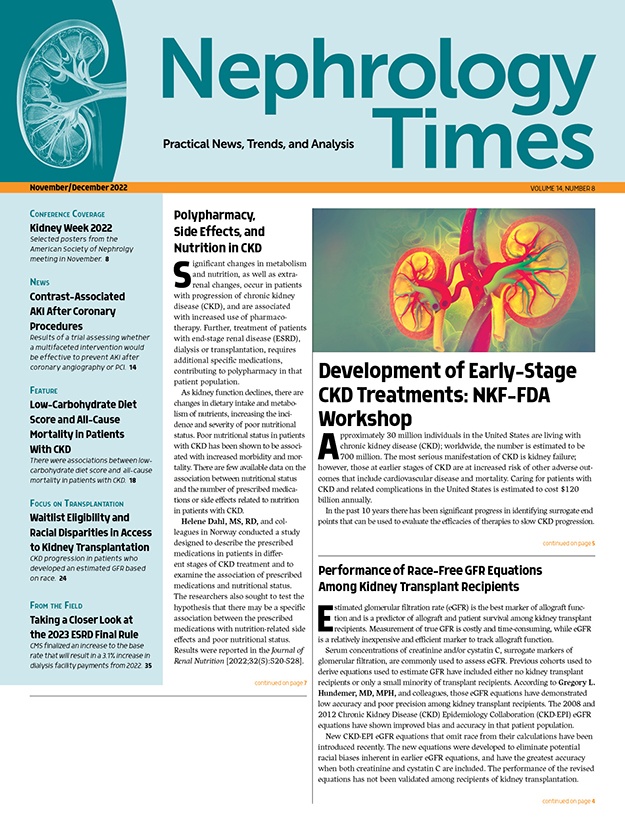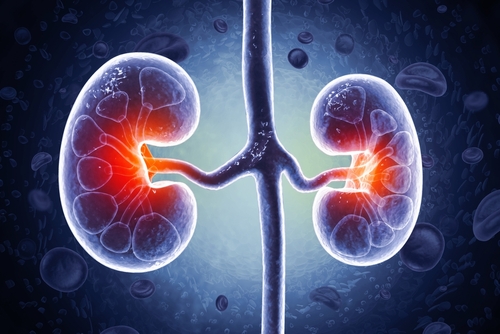
Significant changes in metabolism and nutrition, as well as extra-renal changes, occur in patients with progression of chronic kidney disease (CKD), and are associated with increased use of pharmacotherapy. Further, treatment of patients with end-stage renal disease (ESRD), dialysis or transplantation, requires additional specific medications, contributing to polypharmacy in that patient population.
As kidney function declines, there are changes in dietary intake and metabolism of nutrients, increasing the incidence and severity of poor nutritional status. Poor nutritional status in patients with CKD has been shown to be associated with increased morbidity and mortality. There are few available data on the association between nutritional status and the number of prescribed medications or side effects related to nutrition in patients with CKD.
Helene Dahl, MS, RD, and colleagues in Norway conducted a study designed to describe the prescribed medications in patients in different stages of CKD treatment and to examine the association of prescribed medications and nutritional status. The researchers also sought to test the hypothesis that there may be a specific association between the prescribed medications with nutrition-related side effects and poor nutritional status. Results were reported in the Journal of Renal Nutrition [2022;32(5):520-528].
The cross-sectional observational study included adult, primarily White patients at different stages of CKD. Patient recruitment occurred from November 2014 until July 2018. Patients’ electronic health records were used to obtain information on prescribed medications. Polypharmacy was defined as five or more medications simultaneously and excessive polypharmacy was defined as prescription of ten or more medications simultaneously. Medications were grouped as per nutrition-related side effects (xerostomia and nausea).
Nutritional status was assessed using anthropometric measurements of height, weight, body mass index (BMI), mid-upper arm circumference (MUAC), skinfold thickness triceps (SFT triceps), and waist circumference (WC). Muscle strength was measured by handgrip strength. Nonfasting blood samples were obtained (prior to hemodialysis in the subset undergoing dialysis) and analyzed using standard methods.
Participants were grouped in three ways: (1) as per current CKD treatment (predialysis, dialysis, or transplant); (2) as per CKD stage defined by estimated glomerular filtration rate (eGFR); and (3) as per prescribed medications with nutrition-related side effects (xerostomia and nausea). Linear regression analysis adjusted for age, sex, and eGFR was used to examine the association between the number of prescribed medications and the measures of nutritional status.
The study cohort included 217 patients with CKD. Of those, 112 had predialysis CKD stages 3-5, 33 had ESRD receiving hemodialysis, and 72 had received a kidney transplant. Mean age was 60 years (range, 21-89 years) and 71% were male. Those in the kidney transplant group had the highest eGFR and the lowest mean age. The most common primary kidney disease was nephropathy caused by diabetes or hypertension (28%), followed by glomerular disease (25%), and polycystic or unspecified cystic kidney disease (14%).
On average, patients were prescribed nine medications. A total of 216 medications were prescribed for the entire study cohort. Polypharmacy was observed in 84% of study participants, and excessive polypharmacy was present in 37%.
Most patients had prescriptions from the group of cardiovascular system medications (94%) and from the group of prescriptions for the alimentary tract and metabolism (84%). When the medications were grouped according to nutrition-related side effects, 66% (n=143) of the patients were prescribed at least one medication with nausea as a side effect (36 different medications) and 24% (n=51) with xerostomia as a side effect (21 different medications).
There was a positive association between the number of prescribed medications with either nausea or xerostomia as a side effect and the total number of prescribed medications. There was a negative association between medications with either nausea or xerostomia as a side effect and eGFR.
Sixty-two percent of participants (n=133) were either overweight or obese (BMI >25 kg/m2) and 48% (n=104) had central obesity (WC >102 cm for men and >88 cm for women). A higher proportion of female participants had central obesity compared with male participants (62% vs 42%, respectively). Thirty-seven percent of participants (n=80) were normal weight (BMI 18.5-24.9 kg/m2) and three patients were underweight (BMI <18.5 kg/m2).
The association between the number of prescribed medications and various measures of nutritional status was examined using linear regression analysis, adjusted for age, sex, and eGFR. There were inverse associations observed between the number of medications and MUAC, SFT triceps, handgrip strength, hemoglobin, and serum albumin.
Additional linear regression analyses with adjustments for sex, age, eGFR, and the total number of prescribed medication were conducted to investigate prescribed medications with nausea or xerostomia as a side effect. There was an association between medications with nausea as a side effect and lower MUAC, SFT triceps, albumin, and hemoglobin. Medications with xerostomia as a side effect were associated with lower handgrip strength.
In citing limitations to the study findings, the researchers included the cross-sectional design that precluded derivation of causal relationships, collecting data on prescribed medications from patients’ health records that do not indicate actual intake, not accounting for over-the-counter medications, and lack of assessment of participants’ physical activity.
In conclusion, the authors said, “In this study, medication prescriptions were associated with poor nutritional status in patients with CKD. Monitoring of nutritional status in patients with CKD with long medication lists is warranted to identify and treat patients with poor nutritional status. The methodology in our study offers a new approach to categorize medications, and larger longitudinal studies should be conducted to confirm our findings. Future studies should also focus on the mechanisms behind the observed associations between prescribed medications and nutritional status and offer a more comprehensive analysis of both side effects and specific medications for patients with CKD.”
Takeaway Points
- Researchers reported results of a cross-sectional study examining the association between prescribed medication and nutritional status in patients with chronic kidney disease (CKD).
- On average, patients in the study cohort were prescribed nine medications concurrently. There was an inverse association between the number of medications and mid-upper arm circumference, skinfold thickness triceps, handgrip strength, serum albumin, and hemoglobin.
- There was a positive association between the number of prescribed medications with either nausea or xerostomia as a side effect and the total number of prescribed medications.







 © 2025 Mashup Media, LLC, a Formedics Property. All Rights Reserved.
© 2025 Mashup Media, LLC, a Formedics Property. All Rights Reserved.